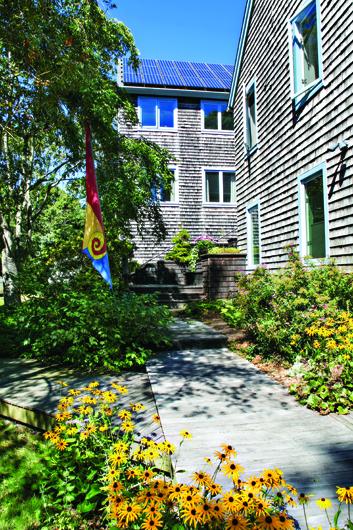Back in 2002, architect Kate Warner set a goal for all of Martha’s Vineyard: install 500 rooftop solar arrays by 2010. Twelve years later, 223 photovoltaic systems have received state rebates for solar systems or are registered for the solar certificates program. Another two dozen were installed before these two programs were in place, estimates from Rob Meyers of South Mountain Company in West Tisbury.
The progress reflects a general consciousness about energy use on the Vineyard, which stems perhaps from an awareness of climate change, and an understanding of the Island’s unique position when it comes to electricity.
Power company NSTAR runs four undersea cables between Falmouth and the Vineyard, providing the electricity Islanders rely on throughout the year. On a hot day this past August, demand through those cables was thirty-one megawatts. Solar decreases that dependence, installers say. “It is a resilience factor,” said John Abrams, who founded South Mountain Company in the 1970s. “We rely on a cable, or a few cables, that might not always be reliable. We rely on backup generators at peak times, and if we can replace that, we are as an Island more resilient.”
South Mountain has integrated solar technology into its projects from the beginning. But over the years, solar has become a bigger part of the business, and in 2006, solar installation became a separate division within the company. By 2011, South Mountain systems produced a collective 130,000 kilowatt-hours (kWh), a number that soared to 410,000 in 2012, and 908,000 in 2013. It expects to produce 1.4 million kWh in 2014, enough to power an estimated 197 homes.

As the cost of solar panel production has decreased, state and federal incentives have proliferated, making “going solar” more economical than ever. “There are certain places where costs and incentives have worked together to make pockets of deep penetration, and the Vineyard is one of them,” Abrams said.
The state of Massachusetts placed fourth in new kilowatts of solar power capacity added in 2013, ranking behind only sunny states California, Arizona, and North Carolina. But while it’s growing quickly, solar power remains a small sliver of the energy pie in the Commonwealth, and in the country at large. In August, the Boston Globe reported that solar provides about 1.5 percent of the state’s overall energy production, or enough to power roughly 94,000 homes.
Warner set her goal as part of a grant she received from the Department of Energy’s Million Solar Roofs Initiative, which inspired her to promote solar installations and energy awareness Island-wide. Still, many homeowners remain unmotivated or unwilling to take the solar plunge.
According to Bill Bennett of Solar Invictus in Vineyard Haven, the limiting factor is often education. He cited a 2012 Harris poll that found that 97 percent of Americans overestimate the cost of a solar installation. In his opinion, considering the current incentives, “It’s the best investment you can make. Its a real no-brainer.”
Most of our electricity continues to be produced by coal and natural gas plants. Both have health and environmental impacts that some say mask their real costs to society. Absent the direct and indirect subsidies that make for artificially low energy prices, Meyers believes, solar panels would be on every appropriate roof.
“Solar parking canopies would cover all of our parking lots, and electric vehicles would be everywhere,” he said. “Imagine how quiet the roads would be.”





